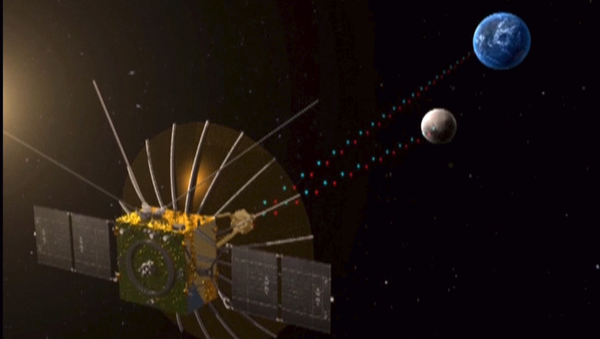China's National Space Administration (CNSA) has accelerated its moon program in recent years, making a major leap in May when it put the Queqiao satellite into position on the far side of the moon. CNSA has indicated the satellite is a relay, to be used for coordinating communication with the side of the moon that never faces Earth, but Jeff Gossel, the senior intelligence engineer in the Space and Missile Analysis Group at the US Air Force's National Air and Space Intelligence Center, said last Friday that Queqiao's unique location — the moon-Earth system's Lagrangian-2 (L2) point — could also be a key part of a space war campaign against the US' precious geosynchronous Earth orbit (GEO) navigation and communication satellites.
Quequiao sits at the Lagrangian-2 point, a location about 279,600 miles from the Earth, a spot just beyond the moon where a gravitational equilibrium can be maintained between the two bodies (all two-body systems have five such locations around them). That means Queqiao doesn't orbit the moon, it orbits a small location just behind it — pretty ideal for a communications satellite.
This location will be essential for coordinating China's upcoming lunar missions, of which it has planned at least four, according to Li Guoping, director of the Department of System Engineering at CNSA, Sputnik reported. The Chang'e-4 probe will be on its way to the far side of the moon before the end of the year, and will be followed by exploratory missions to both of the planetoid's poles and, eventually, manned missions. However, Queqiao only has an expected three-year lifespan, Xinhua reported in May.
What Gossel is afraid of, though, is that Queqiao's position would also enable it to support a sneaky, gravity-hooking attack on US intelligence and communications satellites.
"You could fly some sort of a weapon around the moon, and it comes back — it could literally come at [objects] in GEO… and we would never know because there is nothing watching in that direction," he said, Defense One reported. "Why do you need a relay satellite flying around L2? So you can communicate with something that's going to land on the other side of the moon — or so you can fly around the other side of the moon? And what would that mean for our assets at GEO?"
While Queqiao is a little over a quarter-million miles away, GEO satellites are only about 28,300 miles up. Gossel said that it's "very telling" that the Chinese would put a satellite there and talk about it "in open press."
Of course, what Gossel failed to mention is that China placing Queqiao at Earth-Moon L2 isn't unprecedented — the US already has two satellites there: the ARTEMIS (Acceleration, Reconnection, Turbulence and Electrodynamics of the Moon's Interaction with the Sun) probes, which monitor the Earth's magnetosphere, a gigantic field surrounding the planet that emanates from its liquid iron core, protecting Earth from harmful solar rays.
So why the fuss? Defense One gives a clue to the answer: defense contractors working for US President Donald Trump's newly minted sixth branch of the armed forces, the Space Force, have been pitching two ideas to the US government: the imminent danger posed by the Russian and Chinese space agencies to US space infrastructure and the need to develop a new generation of cheap, small, disposable navigation satellites to replace the big, expensive hulking GEO satellites.
"China and Russia now have the capability to go after" intelligence and communications satellites in GEO, Michael Griffin, defense undersecretary for research and engineering, told reporters in August, Defense One reported. "Those assets are what we use for communication and reconnaissance and missile warning and position, timing and navigation, a whole bunch of features that we use for war fighting."
Also in August, Sputnik reported on the Pentagon's $117.5 million Defense Advanced Research Projects Agency (DARPA) program called "Blackjack," which aims to produce a network of GPS satellites by 2022 that are easily replaceable, in case someone starts shooting them down or they simply get old and obsolete. The proposed satellites will form a web close to the Earth — only 620 miles up instead of the distant 28,300 miles — composed of at least 90 satellites, based on developments made in the private sector toward that end by space companies like SpaceX.
Earlier that month, US Vice President Mike Pence told reporters at the Pentagon that the Space Force was created primarily to address the "highly provocative demonstration of China's growing capability to militarize space," Sputnik reported. In particular, he pointed to a 2007 test that proved China's ability to shoot down objects in low Earth orbit (LEO, about 100 to 1,200 miles up) using ground-based missiles.
The same day Pence spoke, August 9, the Pentagon submitted a report to the Congressional Defense Committees in which it noted that the US was in danger of losing its edge in space to rising powers, warning that "those potential adversaries are now actively developing ways to deny our use of space in a crisis."
"China and Russia, our strategic competitors, are explicitly pursuing space warfighting capabilities to neutralize US space capabilities during a time of conflict," the report stated.
Bruce Gagnon, coordinator of the Global Network Against Weapons & Nuclear Power in Space, told Radio Sputnik at the time, "What is really driving [the creation of the Space Force] is that the aerospace industry has long said that full-blown ‘Star Wars' would be the largest industrial project in the history of the planet Earth. And they recognize that they can make all kinds of money if they can really concretize a new service-level space force and sink huge money into it, and I think that's really what's driving it."
In that light, Gossel's fears about Queqiao seem somewhat far-fetched and more in line with the concerns of defense contractors than with real dangers posed by the satellite. Brian Weeden, director of program planning at the Secure World Foundation, told Defense One that "speculating about military applications for China's lunar program is akin to Soviet concerns about the Space Shuttle being a potential weapon. There is a grain of truth behind the Shuttle being a space weapon and the Chinese lunar program having possible military applications. Doesn't mean either is reality, though."





